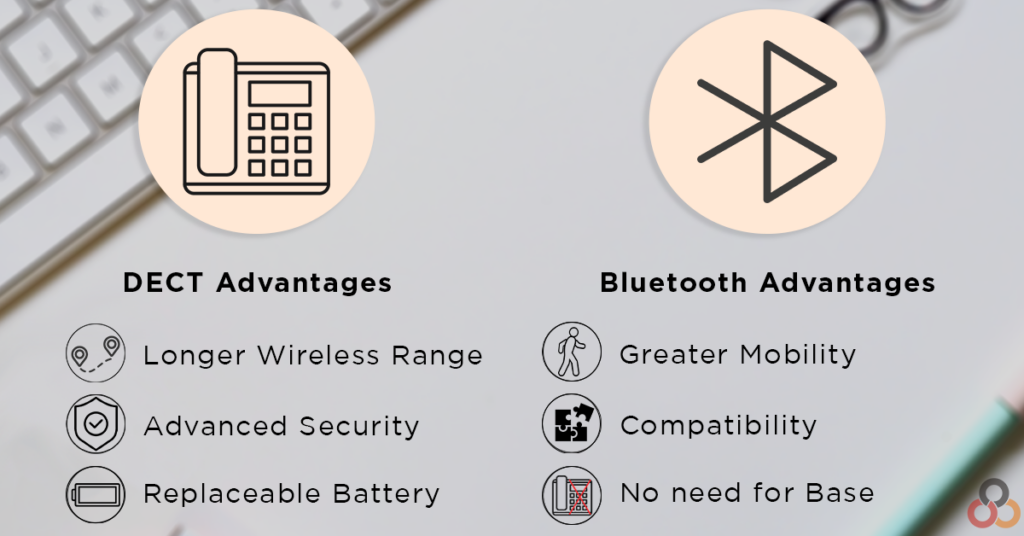DECT Vs. Bluetooth
If you’re searching for endpoints and not sure what the difference between DECT and Bluetooth is, you’re in the right place! But before we get into a direct comparison of DECT Vs. Bluetooth, you may be asking, what are they?
What is DECT?
Originating In Europe around 1992, the acronym DECT originally stood for “Digital European Cordless Telephony.” After the enhancement of the technology and its spread into other countries, DECT became known as its name today, “Digital Enhanced Cordless Telecommunications.”
Devices that use a DECT-based connection operate with a digital encryption code as opposed to analogue radio signals. With a DECT setup, there is a handset (“Portable Part”) that is constantly sending signals to and communicating with a base station (“Fixed Part”).
What is Bluetooth?
With many devices embracing it (and some even removing headset jacks to force its use), Bluetooth has become a household name. By using radio waves instead of traditional wires, a Bluetooth device can connect and transmit data to another Bluetooth-enabled device. In simpler terms, Bluetooth allows for the exchange of data between two or more devices within a short range of each other. These devices can be headsets, phones, laptops, printers, the list goes on. Another distinguishing factor of Bluetooth is that it doesn’t need a base station—any Bluetooth-enabled device can connect to another one directly.
DECT Vs. Bluetooth: The Differentiators
So, which of these two connectivity options are better? The answer isn’t as simple as it may seem—both options have pros and cons associated with them. Let’s explore some of the main differentiating factors:
Distance & Mobility
One of the largest differences between DECT Vs. Bluetooth is wireless range. Typically, Bluetooth provides a wireless talk range of 30 feet. DECT headsets, on the other hand, provide a wireless range of around 350 feet. This is mostly on account of their differences in frequency and power. DECT operates at a lower frequency than Bluetooth (1.9ghz vs. 2.4ghz), and with radio frequencies. lower frequency generally leads to greater range. DECT also is able to operate at a higher power level vs Bluetooth as the 2.4ghz band used by Bluetooth is a shared frequency with other services such as consumer WiFi.
Similarly, obstacles that can impede these radio waves should be taken into consideration. Range of both Bluetooth and DECT devices is highly dependent on obstacles that come between the two devices. DECT allows for greater range already, but it also can somewhat make up for losses through concrete obstacles, while Bluetooth cannot.
Although DECT wins out on distance, Bluetooth really shines when it comes to mobility. Devices connected through Bluetooth can easily be brought home by a hybrid worker. Whether all they need to do is bring the device and connect wirelessly or additionally bring a Bluetooth dongle, it’s a simple process. On the other hand, DECT is a two-part system with its portable and fixed parts. Both devices are needed for proper function, so it’s a bit more involved to pack up and move, especially in a hybrid work situation where work from home and being in the office involves more device movement.
Security
For everyday use, both DECT and Bluetooth provide a high level of security, making calls virtually impossible to intercept.
DECT actually has a three-level security chain:
- Headset paired with base station through a DECT Standard Authentication Algorithm (DSAA). This validates the initial connection.
- During a call initiation, the portable and fixed parts of the DECT device communicate with one another to ensure the connection is between 2 authorized devices.
- Lastly, the actual call/audio is run through 64-bit encryption to ensure that interception is not possible.
This three-level chain ensures utmost privacy and security for calls, making DECT especially applicable in the healthcare and legal industries that regularly deal in sensitive information. It’s also interesting to note that DECT will not automatically reestablish a connection to a device; once disconnected it must be manually reconnected.
When initially pairing Bluetooth-enabled devices, it also has a similar validation process, with its level of data encryption rising to 128-bit. But adversely to DECT, many Bluetooth devices will automatically reconnect with previously connected devices once in range, which could possibly raise security flags.
Overall, DECT wins out in the security department with its three-level security chain, but this may not be necessary for some industries where high-level data isn’t discussed or stored.
Quality & Connection
Because of DECT’s constant communication between its portable and fixed devices, it can guarantee a stable, clearer connection with minimal drops. Conversely, Bluetooth is more prone to interference and occasional drops of quality, especially in spaces with many different Bluetooth devices. For this reason, DECT may be a better choice for rooms that need a lot of devices, such as an office space with many cubicles/telecommunications agencies, and Bluetooth may be better suited to a work-from-home situation where interference isn’t as likely.
Advantages with Both:

Still overwhelmed choosing DECT Vs. Bluetooth devices for your portfolio? Let us help you find your match. Our Sales Team can walk you through the decision-making process. Reach out to learn more!


